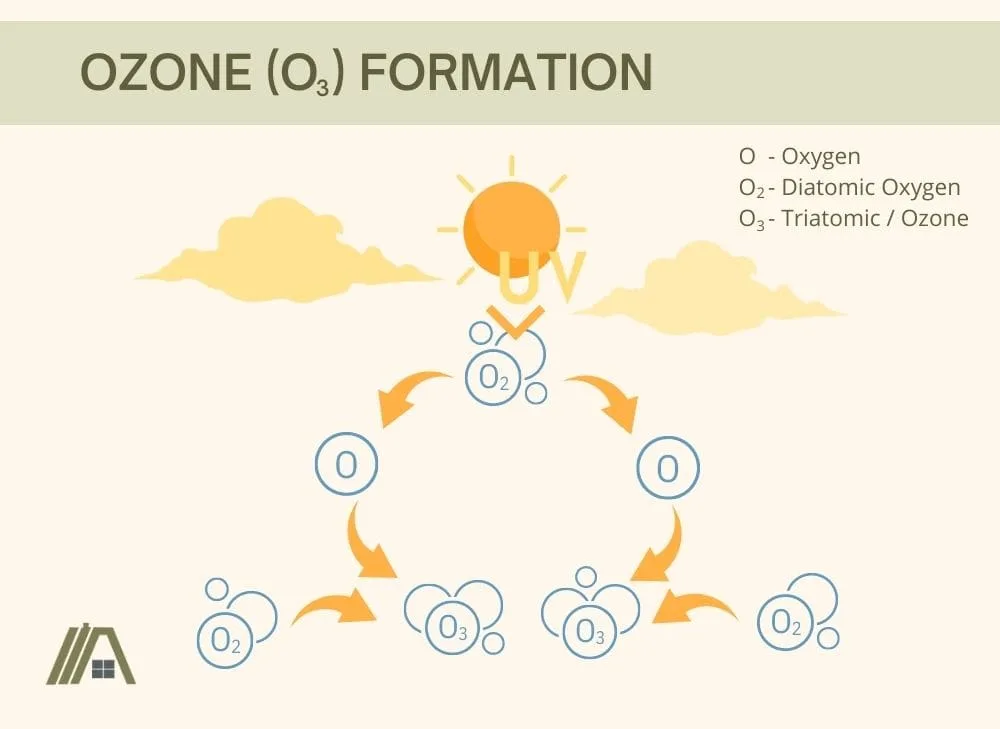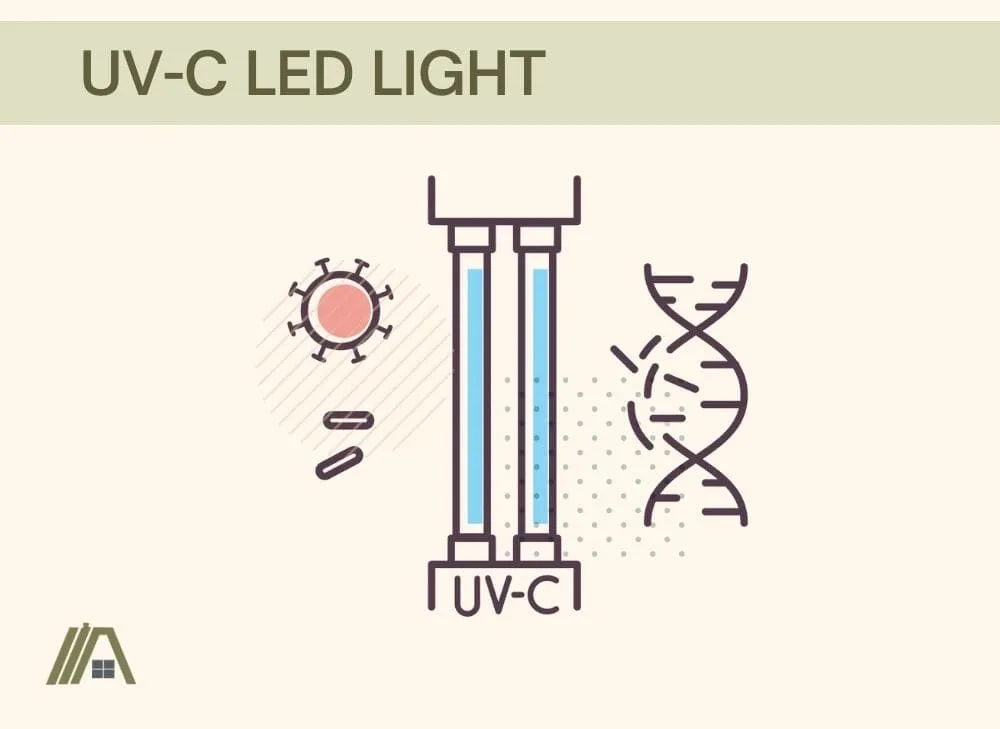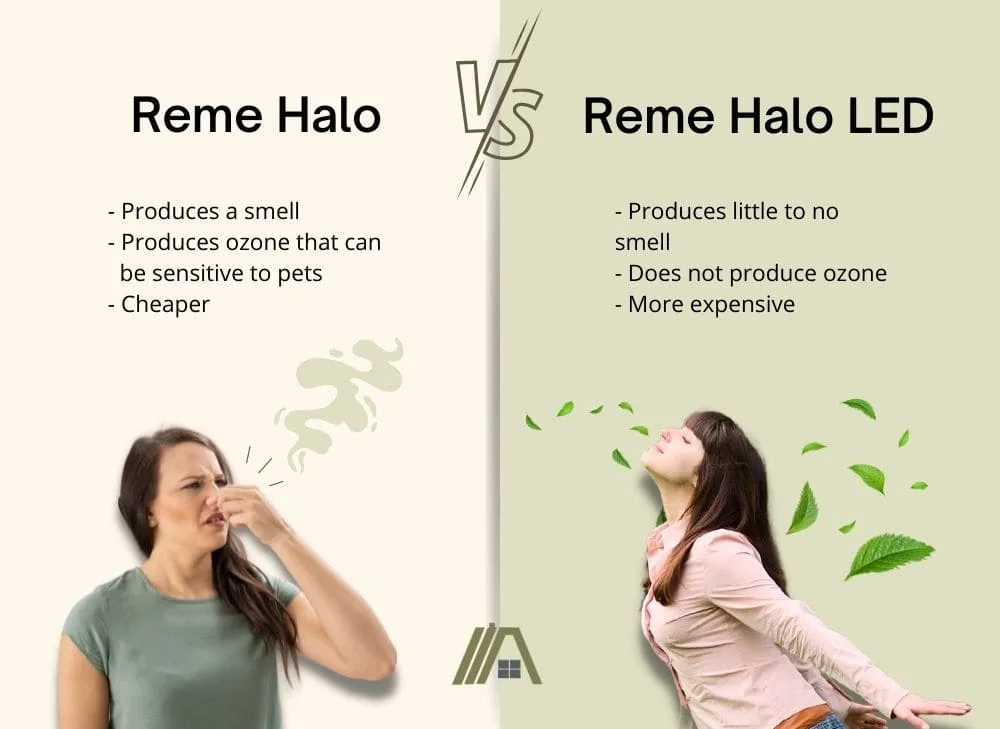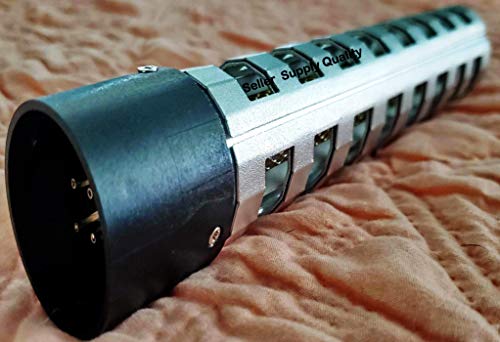
Reme Halos use broad-spectrum UV and metal catalytic targets. Ozone, which has a slight smell, is a byproduct. Halo LEDs use UV-LED and ceramic targets. Ozone and odors are absent. Halos cost less and are quicker to install. LED cells last longer, don’t run continually, and the units have longer warranties.
Difference Between Reme Halo and Reme Halo LED: Overview
Although they are different, the Reme Halo and Reme Halo LED do share some similarities. They are both installed in HVAC systems and produce ionized hydrogen peroxide ions, which purify the air. Both use a light source and a catalytic surface for this production.
The most distinguishing difference between the two is that the Reme Halo uses a broad-spectrum UV light while the Reme Halo LED uses a UV-C LED light, which only emits light of certain wavelengths.
What is the Reme Halo?
The Reme Halo is a type of ionizing air purification system that is installed in your air vents. It removes viruses, bacteria, VOC, and dust particles from your home (or your office) through a process called photohydroionization, thereby improving the air quality.
Cost and Availability
The Reme Halo is not difficult to buy. You can find it online and many HVAC contractors will stock them, so you can by the product and hire the crew for installation at the same time.
You are not going to be spending thousands on this device, even with the additional costs of replacement cells.
The price of installation might just pip you over the $1,000 mark, but the labor costs shouldn’t be unreasonable because installation takes about 30-60 minutes and you can compare prices among the various companies offering the Reme Halo.
No products found.
Mechanism of Action
The Reme Halo is installed within an HVAC system and works so efficiently due to three important factors. Namely, the metal surface that acts as a catalytic target, hydrate that coats the metal plate and traps moist air, and a broad-spectrum UV light source.
These factors work together to produce ionized hydrogen peroxide molecules through photohydroionization.
The air that flows through the HVAC system into your space, passes through the Reme Halo, which is placed in the supply plenum. In doing so, the air is ionized, creating a plasm of charged hydroperoxide particles.
These collide with microbes, disrupting their cell walls and DNA, destroying them, and preventing any multiplication inside your home. This is done by removing the hydrogen atoms from the particles and leaving behind their altered and unstable state.
The ions also give charge to particulate matter like pollen and dander, which then stick together like magnets. The agglomerates are much larger and heavier than the individual allergens, and they are readily caught by the HVAC filters or fall to the ground and other surfaces from where they are easily cleaned up.
Power Supply and Usage
The Reme Halo runs continuously within the HVAC system, regardless of if there is air flowing through it or not. This means that it is producing negative ions (and ozone) within the HVAC system, even when these are not able to travel into rooms to purify the air there.
Any constantly running appliance (where constant running is unnecessary) uses more energy than it should. The cost is not extraordinarily high, but it is around $1.7 per month, which is $20 per year if it operates 24hrs a day.
Its continuous usage may also cause more wear and tear on the product, increasing maintenance costs throughout the years.
What it is Effective Against
The main victims that succumb to the attack by ionized hydroperoxide are airborne particles such as dust, pollen, mold spores, and dander.
Airbourne pathogens like viruses are also targeted by the Reme Halo. It may even be used to eliminate COVID-19, according to initial studies done by a third party. However, this study is not available online.
The Reme Halo is also effective against foul odors, so no more stinky gym socks or cooking odors hovering around your space. Chemical odors like those associated with VOCs aren’t as effectively removed, though.
Byproducts
The broad-spectrum UV energy is used to release electrons from the metal target plate, a process that is catalyzed by the presence of the hydrate, which traps ambient moisture.
However, some of the wavelengths emitted by these light sources have enough energy to split diatomic (containing two atoms) oxygen molecules apart to produce free oxygen atoms. Oxygen atoms are not happy being alone because this is not the most chemically stable state for them. This means that they are drawn to other oxygen atoms and molecules in the air.
If they bind to another oxygen atom, you just get the harmless diatomic oxygen molecules that we breathe in all the time. If, however, they bind to other diatomic oxygen molecules, you get triatomic oxygen, better known as ozone.

Ozone can be harmful if the concentrations are high enough. Typically, the Reme Halo only produces minute amounts, which fall below levels that are toxic to a healthy person.
Ozone is actually a substance that helps to clean the air. However, over the years, people are becoming increasingly uncomfortable with the idea of adding potentially toxic molecules into the air in order to clean it.
In addition to helping to clean the air, ozone is marked by a “fresh” or “clean air” smell. Some find it pleasant while others, who are sensitive to odors or don’t like the idea that they are breathing in ozone, may find it offensive.
Usually the smell is only present when you first turn on the HVAC system because the Reme Halo has been running in the off HVAC system, building up ion plasma and ozone.
Cell Replacement Frequency and Warranty
To achieve maximum ionized hydrogen peroxide output, the Reme Halo cell would need to be replaced every 2 to 2.5 years. Considering that it is continuously running, there is a lot of wear and tear on the product, hence a high replacement frequency.
- Recommended Cell replacement
- For remote Halo in-duct air Purifier
- The reme Halo can be installed in a wide variety of residential, Commercial and industrial applications where a ducted HVAC system exists.
Last update on 2024-03-27 / Affiliate links / Images from Amazon Product Advertising API
There is a 5-year warranty on the ballast (a device that regulates current flow to the bulbs) and a 2-year warranty on the cell. If you do the installation yourself, however, your warranty will not be eligible.
What is the Reme Halo LED?
The Reme Halo LED is the new and improved model of the original Reme Halo. The Halo LED is the first LED in-duct air purifier and performs very similarly to its predecessor.
Cost and Availability
Once again, you can buy the Reme Halo LEDs online and from HVAC contractors. RGF, the manufacturers, even have a search page you can use to find the nearest contractor that stocks and sells the Reme Halo LED.
- Kit includes the REME-LED and HLED-AS
- REME-HALO-LED with HLED-AS Air Switch
- Installation by a Licensed Electrical or HVAC Professional is Recommended; RGF DOES NOT WARRANTY THIS PRODUCT; Contact Your Distributor for Warranty Support
- Installation by a Licensed Electrical or HVAC Professional is Recommended; RGF DOES NOT WARRANTY THIS PRODUCT; Contact Your Distributor for Warranty Support
Last update on 2024-03-27 / Affiliate links / Images from Amazon Product Advertising API
As you can see, the Reme Halo LEDs are a bit more expensive than the previous generation, but that’s because the technology is more advanced. In the following sections, you will see the benefits of this advanced technology.
Installation can also be a little more expensive because it takes longer—about 45-90 minutes.
Mechanism of Action
The mechanism that is used in Halo LED is not that much different from the mechanism used in the Halo.
In fact, this product is also installed in the HAVC system, and it also produces ionized hydrogen peroxide, just like the Halo. These still attach to microbes, disrupting their cell walls and they still make allergens clump together to be filtered out.
However, probably the biggest difference between the two models is that the Halo LED uses a UV-LED light source instead of a broad-spectrum UV light source. LED light sources can be programmed to emit germicidal wavelengths with ranges from 200-280 nm.

These are UV-C LED light sources, and they do not have enough energy to split oxygen molecules, which could have created ozone. More on this later.
In addition, instead of a metal catalytic target structure, the LED uses a hybrid ceramic material that is actually washable.
Power Supply and Usage
The Halo LED is slightly more energy efficient than the Halo. The Halo LED only switches on when air moves through the system (when your HVAC system is turned on) and does not run continuously like the Reme Halo.
Thus, this product is slightly more economical as the wear and tear is reduced by its ability to perform only when necessary. This will also reduce maintenance costs, like cell replacement costs which we will touch on later.
What it is Effective Against
The Reme Halo LED is effective against the same pathogens, airborne particles, and odors as the Reme Halo.
There is no difference in the type and amount of negative ions produced by the Reme Halo and the Reme Halo LED. The LED model “wastes” less light energy by only producing light of wavelengths that will ionize the air.
Byproducts
The UV-C LED light source has enough energy to ionize the air and produce an effective amount of hydrogen peroxide ions. However, it lacks light wavelengths that have enough energy to split oxygen molecules. Thus, no free oxygen atoms and molecules can bond together to form ozone.
If you are sensitive to smells you would be pleased to know that Reme Halo LED doesn’t produce a smell. This is because it doesn’t produce ozone and because it doesn’t run continually, building up in the closed ducts.
There is also no Mercury present in these light sources.
Cell Replacement Frequency and Warranty
The Halo LED cells only need to be replaced every 4-4.5 years. Their ability to switch on only when there is airflow allows for less wear and tear on the cell, which will reduce the replacement frequency.
- Genuine OEM Component
- OEM RGF Component
Last update on 2024-03-27 / Affiliate links / Images from Amazon Product Advertising API
Halo LED cells are easily replaceable but will cost more than the older models.
There is a 7-year warranty on the ballast and a 4-year warranty on the cell.
Table of Differences Between Reme Halo and Reme Halo LED
| Reme Halo | Reme Halo LED | |
| Cost | $780 (including installation) | $1,180 (including installation) |
| Installation time | 30 to 60 minutes | 45 to 90 minutes |
| Light source | Broad-specturm UV light | UV-C LED |
| Photocatalyst type | Zinc (metal) | Ceramic material that is washable |
| UV Purification and power usage | Continuous More power usage | Only switches on when HVAC is operating Lower power usage |
| Ozone Production | Yes but low | No ozone production |
| Odor presence | Slight odor | Little to no odor |
| Cell replacement | Every 2 to 2.5 years | Every 4 to 4.5 years |
| Warranty | Cell warranty: 2 years Ballast warranty: 4 years | Cell warranty: 4 years Ballast warranty: 7 years |
Should I Get the Reme Halo or Reme Halo LED?
One’s decision on which air-purifier is best will depend on the individual themselves. There are few differences between the two models, but those that do exist are likely to influence your decision.
Odor sensitivity: If you want your air purifier to release any kind of smell, then the Reme Halo would not be the best option for you. The Halo LED would be a better fit as no odor is produced.
Ozone production: If you are a high-risk individual or you already have a lot of ozone-producing appliances in your home, then the Halo LED is again the better option. Pets are also more sensitive to ozone, so if you have any, the LED will be the best choice.
Budget: If your outlay budget is limited, then go for the Reme Halo. If you are after long-term cost-saving, the Halo LED would be the better choice.

Can You Use a Halo LED Bulb in a Regular Halo?
If you already have a Reme Halo but you like the sound of no ozone as less frequent cell replacement, do you have to upgrade your whole unit or can you just replace the regular cell with an LED cell?
It would be terribly convenient if you could, unfortunately, it’s not possible.
If you look at the replacement cells themselves, you will see that their shapes differ quite a bit.
This means that the LED replacement cell will not fit into the connection point of the original Reme Halo unit.
In addition to the actual shape of the cell, there are differences in the wire connection system. As you can see from the second picture above, there are two wire connectors, one for each side of the cell. If you look at the following video (from about the 4:34 minute mark), you will see that the original Reme Halo has only one wire connector and that it is a different shape to those of the LED.
So, while it would be very convenient and more affordable for us, the users, making the bulbs or cells interchangeable would not be a very prudent step for the manufacturers to take. Sales of LED units and original Halo bulbs would drop significantly.
In addition to this, there may be other unseen differences in the unit construction that could make switching the bulbs potentially dangerous or the air purification less effective.
Sources
https://en.wikipedia.org/wiki/Photoionization
https://rgf.com/products/air/halo-led-whole-home-in-duct-air-purifier/
https://rgf.com/products/air/reme-halo-whole-home-in-duct-air-purifier/
https://moaablogs.org/reme-halo-air-purifier-review/
https://www.protechac.com/blog/reme-halo-vs-reme-halo-led/
https://polairusa.com/air-quality-reme-halo-vs-reme-halo-led/






Jeanette Hedrick
Friday 23rd of February 2024
This article has been very helpful and I hope I have interpreted it correctly. I have Bronchiectisis and cannot be subjected to ozone so I have been researching purifiers which do not produce ozone. Please confirm that I have concluded that the Reme Halo LED does not produce ozone and therefore is not an endangerment to people like myself with pulmonary issues. Thank you.
Michael Scott
Tuesday 26th of March 2024
You are correct. Reme Halo LED does not produce any ozone. It's only the traditional Reme Halo that does.